Fig. 33.1
(a) Lateral cephaloradiograph shows the skeletal structures surrounding the pharyngeal space and allows evaluation of the pharyngeal depth, shape of cervical spine, soft palate size and length, and extent of soft palate elevation. Because it is a two-dimensional representation of the velopharyngeal area and does not show lateral pharyngeal wall motion, this record cannot be used to diagnostically determine velopharyngeal functions. (a) Left: Structures involved in controlling airflow as seen in a lateral cephalograph at 5 years of age (A anterior tubercle of the atlas, CS cervical spine, S odontoid process, W posterior pharyngeal wall, PS pharyngeal space, SP soft palate (velum), HP hard palate, T tongue, M mandible). Right: Air flow when vocalizing “Uuu” during normal speech. The soft palate elevates and makes contact with the adenoids (if present) or the posterior pharyngeal wall during normal speech and swallowing. When the lateral pharyngeal muscles operate in coordination with a competent (adequate length, width, and timing of action) soft palate in a normal skeletal environment most of the air is channeled through the mouth while some enters the nose. This is designated as velopharyngeal competency (VPC). (b) Velopharyngeal Incompetency (VPI). There are usually many reasons for inadequate air flow control. Some are (1) a relatively deep pharynx when related to velar length, (2) inadequate velar elevation and/or pharyngeal wall motion (neuromuscular function), and (3) poor timing of speech with pharyngeal and velar muscle (sensory-motor) function
The pharyngeal orifices of the auditory tubes open into the lateral walls of the nasopharynx. The auditory tube connects the pharynx with the middle ear and serves to maintain an equilibrium of air pressure between the middle ear and the external atmosphere. The superoposterior part of the pharynx contains the pharyngeal tonsil (also called the adenoid).
The velum (soft palate) forms the boundary separating the nasopharynx from the oropharynx. Because the velum is mobile, this boundary is arbitrary. The velum is a muscular body that attaches to the posterior rim of the hard palate and the lateral walls of the posterior part of the oral cavity. The posterior free border of the velum hangs into the oropharynx and ends in a small midline projection, the uvula.
The oropharynx extends inferiorly to the level of the hyoid bone. The anterior wall of the oropharynx, inferior to the opening into the oral cavity, is formed by the posterior surface of the root of the tongue.
The palatopharyngeal fold (posterior faucial arch) extends from the sides of the velum into the lateral walls of the pharynx. This muscular fold forms the greatest lateral constriction between the oropharynx and oral cavity. The superior end of the epiglottis extends superiorly from the larynx into the oropharynx immediately posterior to the root of the tongue.
The nasopharynx and auditory tube are lined by ciliated, pseudostratified columnar epithelium rich in goblet cells and glands that secrete mucus. The pharynx is lined with stratified squamous epithelium where contact between the pharynx and velum takes place and in the portion that serves as a food channel.
33.2 Nasopharyngeal Growth
Variations in the height and depth of the nasopharynx are apparent from birth through the early years of growth and development. Rosenberger (1934) made a longitudinal study of nasorespiratory areas in children from 3 months to 5 years of age. It was his opinion that an enlargement of the nasorespiratory area accompanied growth in the body and great wing of the sphenoid as well as the forward drift of the hard palate. Brodie (1941) demonstrated that the hard palate moves downward, away from the base of the skull, in a parallel manner with increasing age and that this results in a progressive increase in the height of the nasal and nasopharyngeal areas.
In a study of the growth of the pharynx, King (1952) concluded that there is a considerable increase in the vertical dimension of the pharynx resulting from the descent of the hard palate, mandible, and hyoid bone, as well as from an increase in the height of the cervical vertebrae. He concluded that there is no appreciable increase in the anteroposterior dimension of the pharynx after an early age.
According to Scott (1953, 1957, 1958), growth in the height of the pharyngeal area is regulated by the cartilages of the cervical vertebrae. He, as well as Todd and Tracy (1930), attributed growth in the anteroposterior dimension of the nasopharynx to growth at the spheno-occipital synchondrosis. Subtelny (1955; Subtelny and Baker 1956) studied vertical growth of the nasopharynx and observed a steady rate of increase up to 15 years of age. Using a measurement from the posterior nasal spine to the soft tissue of the posterior wall of the pharynx, he observed a general increase in depth of the nasopharynx at the level of the palatal plane. Berkowitz (1989) believes that this increase is due mainly to a change in the curvature of the posterior pharyngeal wall.
Several investigators studying cleft palate subjects have focused attention on skeletal structures closely related to the nasopharynx. Ricketts (1954) found that the basilar portion of the occipital bone varies in its position in relation to the anterior cranial base and that these variations can influence the anteroposterior dimension of the nasopharynx. Brader (1957) reported significantly smaller anteroposterior and vertical nasopharyngeal dimensions in cleft palate subjects than in noncleft individuals and noted that his cleft palate subjects had relatively larger masses of adenoid tissue within the nasopharynx than noncleft individuals. He also observed no significant difference in the angularity of the cranial case in individuals with cleft palate when compared with individuals without clefts.
Moss (1965) studied malformations of the skull base associated with cleft palate deformities and indicated that a flexion of the cranial base (N-S-Ba) placed the basioccipital bone “more anteriorly relative to the sphenoid bone,” thus creating a smaller anteroposterior nasopharyngeal dimension. Subtelny (1955; Subtelny and Baker 1956) showed that width of the skeletal nasopharynx was larger in persons with cleft palate than in normal individuals.
Coccaro et al. (1962) studied nasopharyngeal growth in children with cleft lip and cleft lip and palate using serial cephalometric films on 57 subjects from 3 months to 7 years of age. Comparisons were made with a noncleft group and with narrative data supplied by Subtelny. Results showed that: (1) The cleft palate group had smaller nasopharyngeal height measurements than the normal group, but only up to 3 years of age. (2) By 3 years of age, all three groups had attained approximately 80 % of their respective increases in nasopharyngeal height. (3) Nasopharyngeal depth in the cleft palate group increased slightly more than in the noncleft group (6.8 mm vs. 4.3 mm). (4) The horizontal nasopharyngeal changes in the cleft palate group were shorter than in the noncleft group for most of the age levels studied.
33.3 Functions
The pharynx serves as an air passage connecting the mouth and nose to the lungs via the larynx and trachea and as a food passage connecting the mouth to the stomach via the esophagus. Because these channels are common over part of their length in humans, a sphincter is found at the level of the velum to prevent food from entering the nasal cavities during swallowing.
33.3.1 Swallowing
Constriction of the pharyngeal walls results in changes in the diameter of the pharynx. These changes are important to both swallowing and speech. During swallowing, the lateral and posterior walls of the pharynx move anteromedially, reducing the cross-sectional area of the pharynx. This results in a wavelike constriction that flows down the pharynx and continues throughout the entire digestive tract. The wavelike motion is called peristalsis.
In the initial stage of swallowing, the pharynx constricts around the velum while the velum moves somewhat dorsally and superiorly, closing off the nasopharynx from the oropharynx (a movement called velopharyngeal closure). The oropharynx expands somewhat, and the larynx moves superiorly and ventrally, opening the pharynx to receive the bolus of food. As the bolus moves into the pharynx, the pharyngeal walls constrict behind it, propelling the bolus toward and into the esophagus.
33.3.2 Speech
Oropharyngeal constriction and changes in length also occur during speech. These changes affect the resonant frequencies of the vocal tract and thus change the quality of the voice and influence the perception of what phoneme is produced. The lateral walls of the oropharynx move medially on low vowels and laterally on high vowels.
Velopharyngeal closure for speech eliminates the nasal cavities from the resonance system and permits the buildup of intraoral breath pressure to produce fricative and plosive consonants. The mechanics of velopharyngeal closure for speech are quite different from those for swallowing. During speech, the velum moves superiorly and posteriorly against the posterior pharyngeal wall (Fig. 33.2), while the lateral pharyngeal walls move medially against the sides of the velum (Fig. 33.3). By contrast, velopharyngeal closure for swallowing is primarily pharyngeal.
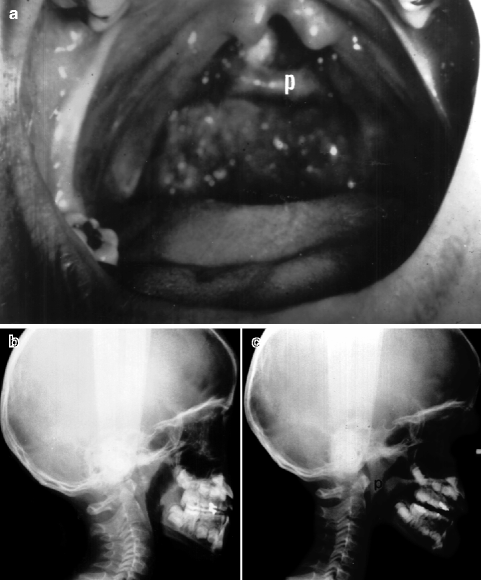
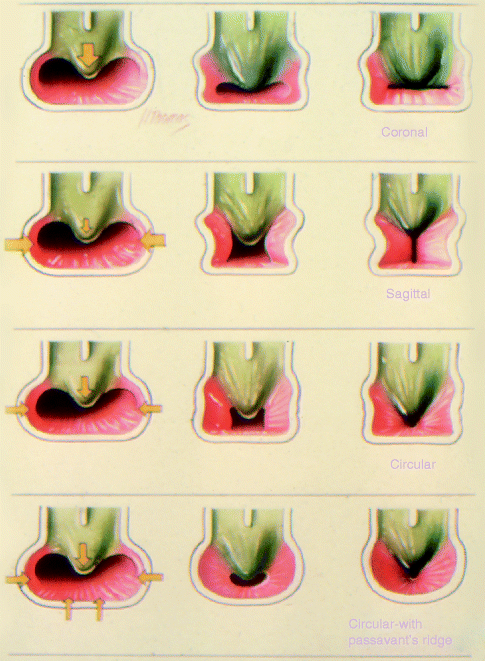

Fig. 33.2
(a–c) Passavant’s Pad. The superior border of the superior constrictor pharyngeus muscle on contraction forms a ridge or pad on the posterior wall. It is observed in both noncleft and cleft patients. There is no consistent relationship of the pad to the velum, and it is usually seen during swallowing as well as during speech, whistling, and blowing. Some state that it functions adequately for compensatory purposes and does not appear to contribute to velopharyngeal closure in all patients. (a) An intraoral view of Passavant’s pads (p). (b) Lateral cephaloradiograph – at rest. (c) While phonating “Uuu,” showing Passavant’s pad (p) at the level of the anterior tubercle of the atlas making contact with the uvulae

Fig. 33.3
Four basic velopharyngeal closure patterns. The size and shape of velopharyngeal valving patterns is very variable (Skolnick 1975). Although the closure patterns are not actually discrete, for convenience sake, Skolnick et al. (1973) categorized velopharyngeal valving into four patterns. These patterns are: Coronal pattern: The majority of valving is palatal with the full width of the velum contacting the posterior pharyngeal wall. The lateral walls move medially to the lateral edges of the velum. There is no motion in the posterior wall. Sagittal pattern: The majority of valving is pharyngeal. The lateral walls move to the midline and approximate each other. The soft palate does not contact the posterior pharyngeal wall but instead abuts up against the approximated lateral pharyngeal walls, thus completing the closure pattern. Circular pattern: There is essentially equal contribution from the velum and lateral pharyngeal walls with the bulk of the musculus uvulae acting as the focal point. The dorsum of the musculus uvulae contacts the posterior wall (which does not move). The lateral walls squeeze around the bulk of the musculus uvulae. Passavant’s ridge pattern: As in the circular pattern, there is essentially equal contribution from the velum and lateral pharyngeal walls, but in addition, the posterior pharynx moves forward. The musculus uvulae also serves as the focal point for closure in this pattern (Reproduced with permission from Siegel-Sadewitz and Sphrintzen (1982))
Radiological studies have demonstrated that, during closure for speech, the velum also increases in length, particularly in its posterior part. The velum contacts the posterior wall just above the level of the anterior tubercle of the atlas and on a plane with the hard palate. Velar elevation is somewhat greater for males than for females, and the greatest velar motion is at the junction of its middle and posterior thirds.
It is of interest to note that both velar elevation and the degree of motion of the lateral nasopharyngeal walls during speech are greater for high vowels than for low vowels. This is the reverse of the activity of the lateral walls of the oropharynx. The degree of motion, and in fact the degree to which complete closure is achieved, depends on both the phoneme being produced and its phonemic context. Motion is greatest for fricatives, less for high vowels, and least for low vowels. The velopharyngeal function is greater for vowels in a nonnasal context than in a nasal consonant context. Finally, the extent of lateral wall motion and the degree of velar motion are synchronized and directly and highly related to each other.
Velopharyngeal closure during speech has received considerable attention, and properly so because it is an important factor in the treatment of cleft patients. It is evident that the tensor veli palatini muscle is not active in velopharyngeal function. The palatopharyngeus is active during velar lowering, but its activity is inconsistent and vowel-dependent. Palatoglossus activity relates more to tongue motion than to velar activity. The superior constrictor and levator veli palatini muscles are the only two velar muscles studied (the uvulus muscle has not been definitively studied) that are active during velopharyngeal function for speech. All investigators agree that levator veli palatini activity is synchronized with velar height.
Indirect evidence indicates that the uvulus muscle plays an essential role in velopharyngeal function. Nasopharyngoscopy has revealed a patient population with hypernasality, a midline longitudinal concavity rather than convexity of the dorsal velar surface, translucency of the longitudinal velar midline, and a small midsagittal gap between the velum and posterior pharyngeal wall during velopharyngeal closure for speech. This lends presumptive evidence that what has been called the levator eminence is actually a function of the uvulus muscle. In lateral projection, the velum may seem to touch the posterior pharyngeal wall, even when there is actually a small central gap because of the absence of the musculus uvulae.
Thus, velopharyngeal closure for swallowing is accomplished by the superior constrictor, levator veli palatini, and uvulus. Closure for speech is accomplished by the levator veli palatini and uvulus. The difference in function during swallowing and speech is also apparent among persons with velopharyngeal insufficiency due to congenital disproportion between the pharyngeal depth and velar length or disproportion following surgery for cleft palate. In our experience, most individuals in this group who are unable to achieve velopharyngeal closure for speech do so consistently during swallowing.
33.4 The Role of the Nasal Cavity (Fig. 33.4a)
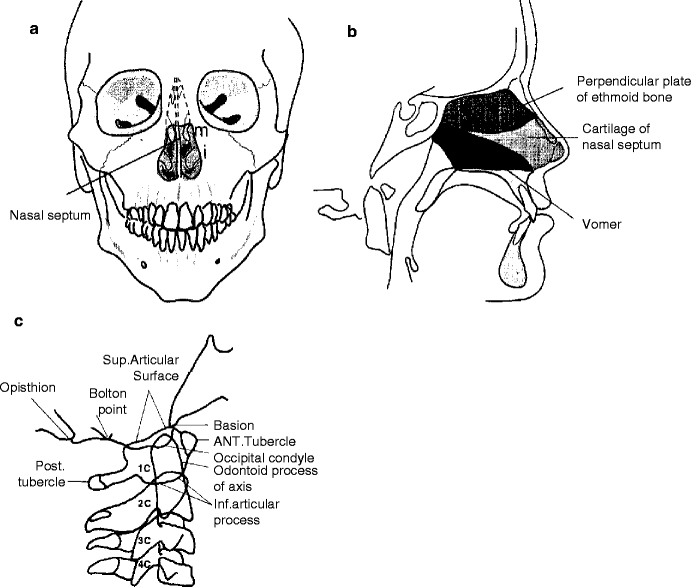
Fig. 33.4
(a) The normal nasal septum: The inferior (i), middle (m), and superior turbinates are attached to lateral nasal walls. (b) The nasal septum is composed of the perpendicular plate of the ethmoid, the cartilage of the nasal septum, and the vomer. In complete clefts of the lip and palate at birth, the nasal septum is displaced to the noncleft side in varying degrees. The configuration of the nasal septum and the turbinates on the cleft side limits the medial movement of the cleft palatal segment after lip and palate repair. (c) Cervical spine: The condition and the relationship of the various vertebrae to each other can influence the depth and configuration of the pharyngeal space. For example, the anterior tubercle of the atlas (1 C, first cervical vertebrae) supports the posterior pharyngeal wall. If it is absent or dislocated, the functional pharyngeal depth may increase to a nonfunctional state
The nasal cavities are the first points of entry and the last points of exit of airflow to and from the lungs. They serve to filter the air as it enters the airway and to control air temperature and humidity. They also serve as resonators for nasal sounds that are produced with the velopharyngeal valve open. The two nasal cavities are separated from each other by the nasal septum in the midsagittal plane. The nasal septum is composed of three parts. The superior part is the perpendicular plate of the ethmoid bone. The inferior and posterior parts are composed of the vomer bone. The anterior part is composed of the cartilage of the nasal septum.
The roof of the nasal cavities is formed by the cribriform plate of the ethmoid bone, which is penetrated by the olfactory nerves. Immediately posterior to the perpendicular plate of the ethmoid is the body of the sphenoid, which contains the sphenoid sinus. The floor of the nasal cavities is formed by the hard palate. Anteriorly, the nasal cavities are bounded by the external nose. The framework of the external nose includes the nasal bones and the nasal cartilages. The bridge of the nose is formed by the nasal bones. Inferiorly, the nasal bones articulate with the lateral nasal cartilages. The tip of the nose is supported by the greater alar cartilages. Small lesser alar cartilages support the lateral walls of the anterior nasal openings.
The lateral wall of each nasal cavity is convoluted owing to the presence of the superior, middle, and inferior nasal conchae. The conchae have an extremely rich blood supply and provide a large surface area for humidity and temperature control of the air passing over them.
Although the terms VP “incompetence,” “inadequacy,” and “insufficiency” historically have been used interchangeably, they do not necessarily mean the same thing. For this reason, standardization of nomenclature has been recommended. Trost-Cardamone (1989) has proposed a taxonomy for VP disorders, based on causative factors in which “velopharyngeal inadequacy is the generic term used to denote any type of abnormal velopharyngeal function.” In the broad group of inadequacies, there are subgroups of structural (VPI), neurogenic (VP incompetence), and mislearning (VP mislearning) or functional origins. VPI includes any structural defects of the velum or pharyngeal walls at the level of nasopharynx with insufficient tissue to accomplish closure or some kind of mechanical interference with closure. The all-encompassing term “velopharyngeal dysfunction (VPD)” does not assume or exclude any possible cause of the perceived speech symptoms or management approach. It applies to speech disorders that may be the result of structural deficits, neurologic disorders, faulty learning, or a combination of sources (Witt and D’Antonio 1993).
33.5 The Use of Lateral Roentgencephalometrics in Evaluating Skeletal Pharyngeal Architecture and Velar Elevation
Velopharyngeal valving is dependent not only on the sensorimotor adequacy of the velum and its synergistic musculature but also on the morphologic skeletal dimensions of the nasopharyngeal port. The size and shape of the nasopharynx are determined, in part, by the contiguous osseous anatomy of the maxilla (Subtelny 1955), cranial base, and vertebral column (Figs. 33.4 and 33.5).
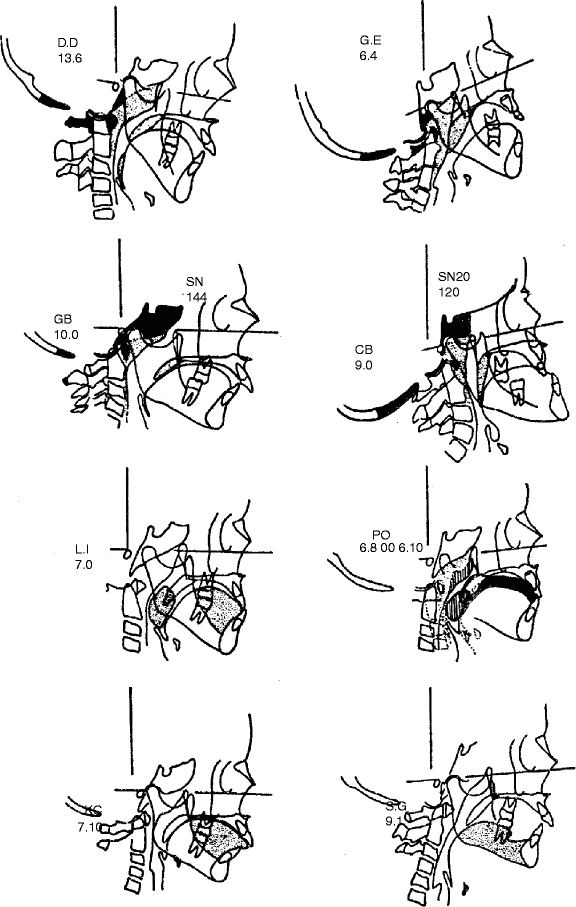

Fig. 33.5
Functional problems related to cervical vertebrae, cranial base, nasopharynx, adenoid, tonsils, and the tongue. DD dorsal displacement of vertebrae, GE congenital deformity with ventral displacement of cervical vertebrae, GB obtuse cranial base upward and backward location of anterior arch of the atlas and severe cleft palate speech (From functional diagnosis of malocclusion)
The mechanism of velopharyngeal closure can be studied to some degree by cephalometric roentgenography, but it must be stressed that this is not a functional test for velopharyngeal competency (Fig. 33.6). The vowel /u/, as in “boom,” is generally employed to achieve maximal elevation of the soft palate during vowel production. After careful rehearsal, the subject is instructed to maintain the sound at a constant pitch and intensity for a time sufficient to cover the roentgenographic exposure period. This procedure ensures that the soft palate will remain in a reasonably stable position during the recording interval.
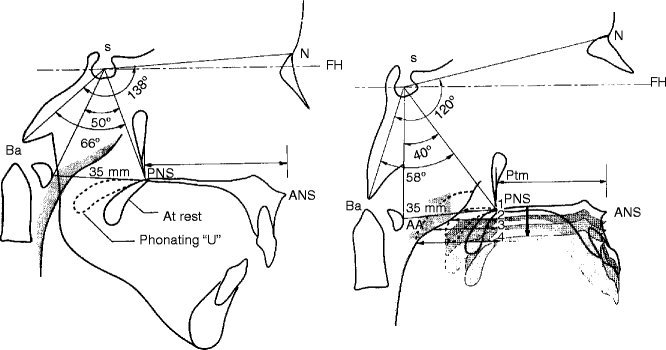

Fig. 33.6
The influence of the skeletal architecture on the pharyngeal form and size. The pharyngeal space is bounded superiorly by the cranial base and laterally by the cervical spine on one side and the tongue/hard palate complex on the opposite side. The odontoid process (axis) of the cervical spine points to the posterior extent (Basion-Ba) of the basilar portion of the occipital bone. It is the median point of the anterior margin of the foramen magnum. The hard palate of the maxillary complex is anatomically associated with the anterior cranial base and can vary in its anteroposterior dimension. The importance of cranial base angle (Ba-S-N). Left: Obtuse cranial base angle. In cases with a severe obtuse cranial base angle, the pharyngeal space is usually deeper than normal even in the presence of a long hard palate. An obtuse cranial base positions the cervical spine more posteriorly since it must be associated with the basilar portion of the occipital bone. This condition is usually seen when hypernasality exists in the absence of an overt palatal cleft and is called congenital palatal insufficiency (CPI). Right: With an acute cranial base angle, the cervical spine is positioned close to the hard palate creating a shallow pharyngeal depth. Comment: These relationships change with growth. The palate descends from the anterior cranial base in a parallel fashion. Due to changing slope of the posterior pharyngeal wall, the pharyngeal depth increases with age. The influence of adenoids: The adenoid is attached to the posterior pharyngeal wall above the level of the hard palate. Its size is highly variable according to age. It usually increases until 13 years of age and then retrogresses, but many variations in this growth pattern have been observed. The influence of cleft size: The severity of the cleft size in complete clefts of the lip and palate at birth does influence the nasopharyngeal width before lip and/or palatal surgery, but not after the lip is united. The degree of mesodermal deficiency of the hard and soft palate can determine not only the size of the cleft space by influencing palatal size but also the length and width of the soft palate and, therefore, its functional ability to affect velopharyngeal closure (VPC). A short anteroposterior maxillary dimension, as is usually found with submucous clefts, does not by itself signify that VPC will be inadequate. Short anteroposterior hard palate dimension can be associated with a shallow pharyngeal depth
Stay updated, free dental videos. Join our Telegram channel

VIDEdental - Online dental courses


